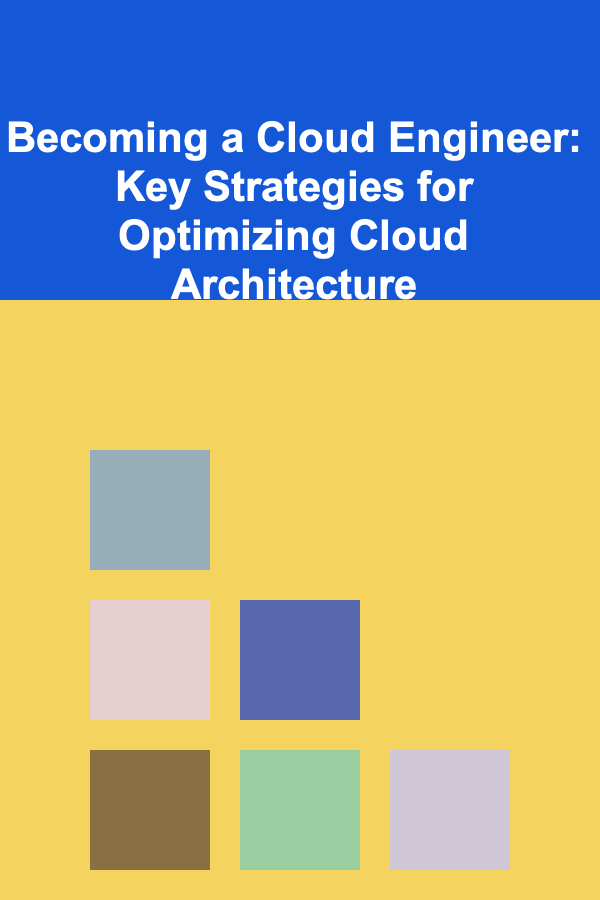
Becoming a Cloud Engineer: Key Strategies for Optimizing Cloud Architecture
ebook include PDF & Audio bundle (Micro Guide)
$12.99$7.99
Limited Time Offer! Order within the next:

The world of cloud computing is rapidly evolving, offering businesses scalable and flexible solutions that were once unthinkable. With the increasing adoption of cloud technologies, cloud engineers play an essential role in designing, deploying, and maintaining these complex architectures. However, to become a proficient cloud engineer and optimize cloud architecture, you need more than just technical knowledge --- you need a strategic approach.
In this guide, we'll explore the key strategies that can help you excel as a cloud engineer, from mastering essential cloud principles to optimizing cloud architecture for maximum performance, scalability, and cost efficiency.
Understanding Core Cloud Computing Concepts
Cloud Computing Models
To be an effective cloud engineer, you must first understand the foundational models of cloud computing. These include:
- IaaS (Infrastructure as a Service): This model provides virtualized computing resources over the internet. It's the most flexible cloud model, allowing organizations to rent computing resources like servers, storage, and networking.
- PaaS (Platform as a Service): PaaS provides a platform and environment for developers to build, deploy, and manage applications. It abstracts much of the underlying infrastructure management, focusing more on the development process.
- SaaS (Software as a Service): This is the cloud-based delivery of software applications over the internet. Rather than hosting software on internal systems, SaaS allows users to access applications through a web browser, reducing the burden of software maintenance.
Key Cloud Providers
When building cloud architectures, you need to be familiar with major cloud providers. The most popular include:
- Amazon Web Services (AWS): A leader in the cloud space, offering a vast array of services ranging from compute (EC2) to storage (S3) to machine learning and artificial intelligence.
- Microsoft Azure: Known for its strong enterprise presence, Azure integrates well with on-premise systems and provides robust cloud infrastructure and development tools.
- Google Cloud Platform (GCP): Known for its strong data analytics, machine learning, and Kubernetes offerings, GCP is highly favored for companies leveraging big data and AI.
Virtualization and Containers
As cloud computing relies on abstraction and resource sharing, understanding virtualization (creating virtual versions of resources like servers and storage) and containers (packaging applications and their dependencies) is crucial.
- Virtual Machines (VMs): These allow you to run an operating system and applications as if they were on a physical server, but in an isolated, virtualized environment.
- Containers: Containers, such as Docker, allow applications to run consistently across different environments by bundling the code and its dependencies together.
Design for Scalability and Reliability
One of the core responsibilities of a cloud engineer is to design systems that scale seamlessly and are reliable under varying loads. Here's how you can approach it:
Horizontal vs Vertical Scaling
- Vertical Scaling (Scaling Up): This involves adding more power (CPU, memory) to an existing machine. While it's simpler to implement, it has limitations and can become expensive.
- Horizontal Scaling (Scaling Out): This involves adding more instances of machines to distribute the load. Horizontal scaling is more cost-effective and can be automated more easily, making it a better choice for cloud environments.
Auto-scaling
Cloud platforms like AWS, Azure, and GCP offer auto-scaling capabilities that adjust resources dynamically based on demand. Implementing auto-scaling ensures your applications maintain high availability and performance during traffic spikes without wasting resources when demand is low.
- AWS Auto Scaling: Automatically adjusts EC2 instance counts based on metrics like CPU usage or memory consumption.
- Azure Scale Sets: Manage and scale sets of identical VMs automatically in Azure.
High Availability and Fault Tolerance
To ensure reliability, cloud engineers need to design systems that are fault-tolerant. This means ensuring that your cloud infrastructure can continue to function even if part of it fails.
- Redundancy: Replicate critical systems across multiple availability zones (AZs) to ensure that if one zone experiences a failure, the others can pick up the load. AWS, for instance, allows you to deploy resources across multiple AZs for fault tolerance.
- Backup and Recovery: Implement automated backup strategies and disaster recovery plans to minimize downtime. Ensure that backups are taken regularly and stored in different regions to prevent data loss.
Optimizing Performance and Cost Efficiency
Cloud resources are highly flexible, but this also means they can be easy to over-provision or underutilized, resulting in unnecessary costs. As a cloud engineer, optimizing cloud architecture for both performance and cost efficiency is critical.
Cost Optimization Strategies
- Right-Sizing Resources: One of the easiest ways to optimize cloud costs is by matching resource provisioning to actual usage. Use tools like AWS Trusted Advisor or Azure Advisor to monitor your resource usage and suggest cost-saving opportunities such as terminating idle instances or switching to reserved instances.
- Spot Instances and Preemptible VMs: Cloud providers offer lower-cost options for instances that can be interrupted. These are ideal for non-critical workloads that can tolerate some downtime.
- Serverless Architectures: Serverless computing, such as AWS Lambda or Azure Functions, allows you to run code without provisioning servers. This model can significantly reduce costs because you only pay for the actual execution time, not idle compute resources.
Load Balancing
A well-implemented load balancer ensures that traffic is distributed evenly across available resources, improving both performance and availability.
- Elastic Load Balancer (ELB) in AWS: ELB automatically distributes incoming traffic across multiple EC2 instances, improving the performance and availability of your application.
- Azure Load Balancer: Provides high availability by distributing traffic to virtual machines in a pool.
Caching and Content Delivery Networks (CDNs)
Implementing caching strategies and using CDNs can improve the performance of cloud applications by reducing latency and offloading traffic from the origin server.
- CloudFront (AWS) and Azure CDN: These services cache static content closer to users, speeding up content delivery and reducing the load on origin servers.
Security Best Practices
Cloud security is one of the most critical aspects of cloud architecture. Protecting your infrastructure, data, and applications should be a priority from the beginning of your design process.
Shared Responsibility Model
Understand the shared responsibility model for cloud security. While cloud providers secure the underlying infrastructure, you are responsible for securing your applications, data, and user access.
- Data Encryption: Always encrypt sensitive data both in transit and at rest. Most cloud providers offer built-in encryption tools, such as AWS KMS or Azure Key Vault, for managing encryption keys.
- Identity and Access Management (IAM): Properly configure IAM to enforce least-privilege access. This involves granting users and services only the permissions they need to perform their tasks.
- Multi-Factor Authentication (MFA): Enable MFA to add an extra layer of security for accessing cloud resources.
Monitoring and Logging
Regularly monitor and log cloud activity to detect potential security threats early.
- AWS CloudWatch and Azure Monitor: These tools allow you to track system performance, detect anomalies, and receive alerts when specific thresholds are crossed.
- CloudTrail and Azure Security Center: Keep track of user activities, API calls, and other system changes to spot any unauthorized access or suspicious activities.
Automation and DevOps Practices
Automation is a key part of managing cloud infrastructure efficiently. By adopting DevOps practices, you can streamline the process of building, testing, deploying, and maintaining cloud-based applications.
Infrastructure as Code (IaC)
Tools like Terraform , AWS CloudFormation , and Azure Resource Manager (ARM) templates allow you to define your cloud infrastructure in code, making it repeatable, version-controlled, and easier to manage. This approach ensures that infrastructure is provisioned consistently and with minimal human error.
Continuous Integration and Continuous Deployment (CI/CD)
Implementing CI/CD pipelines allows for rapid and reliable deployment of updates to cloud applications. Tools like Jenkins , GitLab CI , or Azure DevOps enable you to automate testing, building, and deployment processes, reducing the time required to release new features.
Conclusion
Becoming a cloud engineer involves mastering a wide range of skills and technologies, from understanding cloud computing models and virtualization to implementing cost-effective and scalable solutions. Optimizing cloud architecture requires a balance between performance, cost-efficiency, and security, and being well-versed in automation and DevOps practices will enhance your ability to deploy and manage cloud infrastructure at scale.
As a cloud engineer, it's crucial to stay updated with the latest developments in cloud technologies, as the industry is constantly evolving. By developing a strong foundation in the strategies outlined in this guide, you'll be equipped to design and optimize cloud architectures that not only meet the current needs of your organization but also scale efficiently for future growth.

Best Organization Tools for Gardening Projects
Read More
How to Find the Best Lighting for Your Workspace
Read More
How to Hire a Marriage Event Planner for a Stress-Free Experience
Read More
How to Organize a Family Trivia Night at Home
Read More
How to Soundproof Your Home for a Home Spa Experience
Read More
How to Use Drawer Dividers for Better Utensil Management
Read MoreOther Products

Best Organization Tools for Gardening Projects
Read More
How to Find the Best Lighting for Your Workspace
Read More
How to Hire a Marriage Event Planner for a Stress-Free Experience
Read More
How to Organize a Family Trivia Night at Home
Read More
How to Soundproof Your Home for a Home Spa Experience
Read More